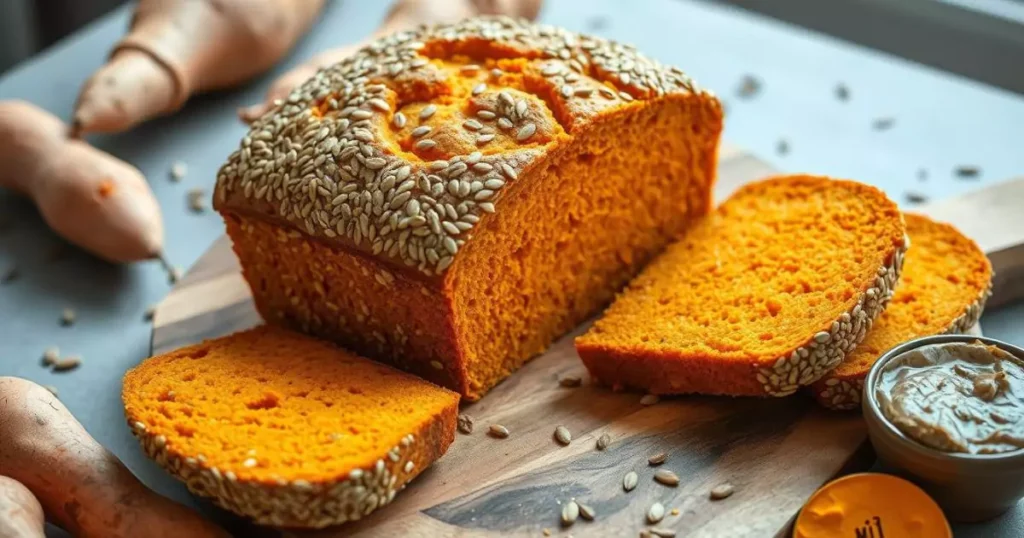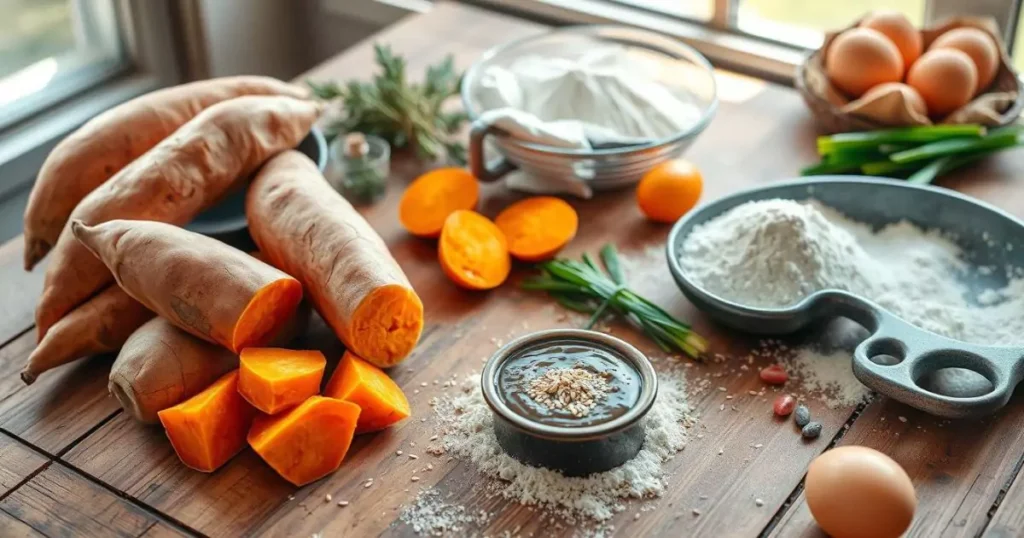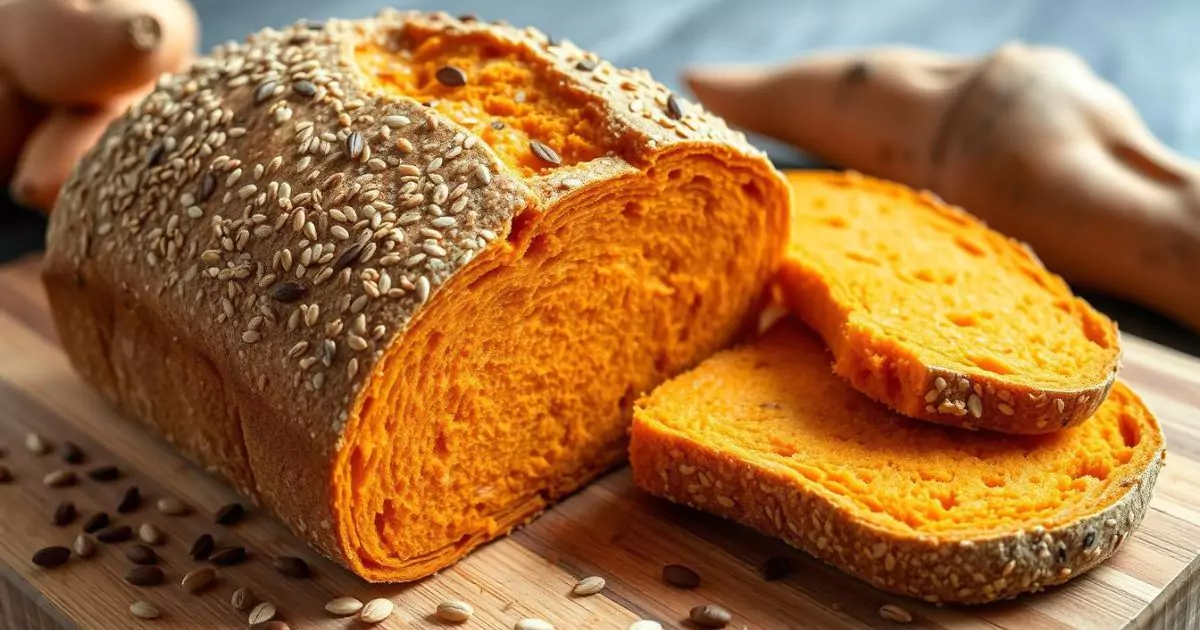seeded miso sweet potato bread recipe
I love bread and the magic it brings to our meals. Today, I’m excited to share a recipe that mixes sweet potatoes with miso. This bread is special because it has seeds that make it even better.
Growing up, the smell of fresh bread was always there. It made me feel happy and connected. Now, I’m mixing old favorites with new flavors, like miso, from Japan.
This seeded miso sweet potato bread is my latest creation. It’s perfect for breakfast, lunch, or dinner. The mix of sweet potatoes, fermented soybean paste, and seeds makes it both cozy and exciting.
Table of Contents
Introduction to Sweet and Savory Bread Making
Bread baking is a world where sweet and savory mix is popular. This mix of flavors opens up new possibilities. It lets bakers create unique tastes that excite our senses.
Understanding Fusion Bread Basics
Fusion bread is a mix of different cooking styles. It combines sweet and savory to make loaves that look good and taste great. This way, bakers can try new things and push bread making limits.
Benefits of Combining Miso and Sweet Potato
Miso and sweet potato in bread is a great example of fusion. Miso adds a deep, savory flavor. Sweet potatoes add natural sweetness and moisture. Together, they make the bread moist and flavorful.
Why This Recipe Works
The seeded miso sweet potato bread recipe is a hit. It adds sunflower, pumpkin, and flax seeds for a nice crunch. This mix of flavors and textures is loved by many, making it perfect for all kinds of bakers.
Essential Ingredients and Their Roles
Making a tasty seeded miso sweet potato bread needs the right mix of ingredients. Sweet potatoes and miso paste are the main stars. They create a mix of flavors and textures that’s amazing.
Sweet potatoes add sweetness and moisture. Miso paste, from fermented soybeans, brings a savory taste that matches the sweet. Whole wheat flour adds a nutty flavor, and eggs help the bread stay soft and together.
A little honey or maple syrup adds sweetness. Vegetable oil makes the bread soft. The seeds on top, like sunflower and sesame, add crunch and nutrients.
Every ingredient in this recipe is important. Together, they make a bread that’s both healthy and delicious. It will make your taste buds happy and your body feel good.
Miso paste, a key ingredient in this recipe, is bursting with probiotics, B-vitamins, and vital minerals, making it a powerhouse for gut health and energy metabolism.
This recipe is great for both experienced bakers and beginners. It shows how mixing wholesome ingredients and seed toppings can make something truly special.

Kitchen Equipment and Setup
To bake the perfect loaf of seeded miso sweet potato bread, you need the right tools and a tidy workspace. Let’s look at the baking essentials and optional kitchen tools that will help you get professional results.
Required Baking Tools
- A 9×5-inch loaf pan for shaping the bread
- Mixing bowls of various sizes for preparing the dough and toppings
- Measuring cups and spoons to ensure accurate ingredient proportions
- An electric mixer or whisk for efficiently combining the ingredients
- A spatula for smoothing the dough and transferring the loaf
- A cooling rack to allow the freshly baked bread to rest and cool
Optional Equipment for Better Results
While the basics will work, some extra tools can make your baking better:
- A food processor for effortlessly shredding or pureeing the sweet potatoes
- A stand mixer with a dough hook attachment for kneading the dough with ease
Preparing Your Workspace
Before mixing and shaping your bread, make sure your workspace is ready. Clear a clean, flat surface and line your loaf pan with parchment paper. This makes baking easier and more fun.
With the right tools and a clean workspace, you’re set to make your own seeded miso sweet potato bread.
Seeded Miso Sweet Potato Bread Recipe
Discover the amazing mix of sweet and savory in this seeded miso sweet potato bread. It blends the natural sweetness of roasted sweet potatoes with the deep flavor of white miso paste. This creates a loaf that’s both satisfying and perfect for any time of day.
First, roast two medium sweet potatoes in a preheated oven at 375°F (190°C) until they’re soft. Let them cool, then mash them. Set the mashed sweet potatoes aside for later.
In a big bowl, mix the mashed sweet potatoes with ¼ cup of white miso paste, 2 tablespoons of honey or maple syrup, 2 tablespoons of olive oil, and 1 teaspoon of vanilla extract. Whisk until everything is well mixed.
In another bowl, combine 2 cups of whole wheat flour, 2 teaspoons of active dry yeast, 1 teaspoon of baking powder, ½ teaspoon of baking soda, and 1 teaspoon of salt. Slowly add the dry ingredients to the wet mixture, stirring until just combined.
- Add ¼ cup each of flaxseeds, sunflower seeds, and sesame seeds to the dough. Mix them in gently.
- Put the dough into a greased 9×5 inch loaf pan. Smooth the top with a spatula.
- Bake the bread for 30-35 minutes, or until it’s golden and a toothpick comes out clean.
- Let the bread cool in the pan for 10 minutes. Then, remove it to a wire rack to cool completely.
This homemade bread stays fresh in an airtight container at room temperature for a week. Or, freeze it in slices for up to 3 months. Enjoy the sweet, savory, and crunchy flavors in every bite of this fusion recipe.
Mastering the Perfect Dough Consistency
Getting the dough just right is key to baking delicious seeded miso sweet potato bread. Understanding baking techniques and dough consistency is crucial. It unlocks the full flavor of this unique bread.
Proper Mixing Techniques
Begin by slowly mixing wet and dry ingredients. Avoid overmixing to keep the dough light and airy. Add the sweet potato and miso paste slowly, until the dough forms.
Temperature Control Tips
Temperature is important for this recipe. Make sure the sweet potato puree is room temperature. Also, warm water is needed to activate the yeast. Keeping the right temperature is key for the perfect dough consistency.
Kneading Best Practices
Kneading is a must-do step. Spend 5-10 minutes kneading by hand or with a stand mixer. This builds strong gluten, supporting the bread’s rise and texture.
For the best results, the sweet potato should be smooth and creamy. This ensures even moisture and flavor in the dough. By following these baking techniques, you’ll make a fantastic seeded miso sweet potato bread.

Seed Topping Techniques and Variations
Add a crunchy texture and extra nutrition to your baked goods with seed toppings. Sesame seeds offer a nutty taste, while pumpkin and sunflower seeds bring earthy flavors. You can top breads, buns, and cookies with a variety of seeds for a stunning look and extra health benefits.
Sprinkle and Bake
Just sprinkle seeds on your dough or batter before baking. This method makes the seeds crispy and adds a nice crunch. A mix of sesame, poppy, and hemp seeds is a classic choice that goes well with many baked items.
Seed-Infused Dough
For a stronger seed flavor, mix the seeds into your dough or batter. This way, the seeds are spread out evenly, making every bite crunchy. Try using roasted pumpkin seeds, sunflower seeds, or crushed flaxseeds to make your breads, rolls, and cookies more interesting and healthy.
Seed Topping Variations
Get creative with different seed mixes to match your taste and dietary needs. Black and white sesame seeds together, or chia, flax, and hemp seeds make for a nutritious topping. You can also use toasted fennel, caraway, or cumin seeds for a savory touch. The choices are endless, letting you tailor your baked goods just the way you like them.
Whether you pick a classic mix or something new, seed toppings will make your baked goods taste better, feel better, and look amazing. Dive into the world of seed combinations and discover the nutritional benefits they bring to your homemade treats.
Baking Process and Timing Guide
To get the perfect bake for your seeded miso sweet potato bread, focus on the baking process and timing. This ensures your loaf has a golden-brown crust and a moist, tender crumb.
Optimal Oven Settings
Preheat your oven to 350°F (175°C) for the best results. This temperature helps the bread bake evenly. It also prevents the crust from burning before the inside is fully cooked.
Visual Cues for Doneness
Watch your bread closely as it bakes. Look for a golden-brown crust and a clean toothpick test. If a toothpick inserted into the center comes out clean, your bread is done.
Cooling and Resting Period
After baking, let your bread cool completely on a wire rack before slicing. This step is key for the bread’s final texture. Don’t slice it too soon – wait at least 30 minutes to an hour.
Follow these baking tips and timing, and you’ll make gorgeous, flavorful loaves. They’ll impress your family and friends.
Storage and Freshness Tips
Keeping your homemade seeded miso sweet potato bread fresh is key. It lets you enjoy its tasty flavors and health benefits fully. The good news is, with the right storage, you can make this bread last longer.
For the best taste, keep the bread in an airtight container at room temperature for 3 days. If you want it to last even longer, slice it and freeze the slices in a ziplock bag for up to 3 months. Don’t put it in the fridge, as it can dry out and lose its softness.
If the bread gets stale, you can make it fresh again. Just toast or warm it in the oven for a few minutes. This trick will bring back its crisp outside and soft inside. By following these tips, you’ll enjoy your homemade bread for days.
FAQ
What is the key feature of this seeded miso sweet potato bread recipe?
This recipe combines sweet potatoes’ natural sweetness with miso’s umami. It creates a perfect balance of flavors. Seeds like sunflower, pumpkin, sesame, and flax add crunch and nutrition.
What are the origins of this bread recipe?
The bread comes from Southern and African-American traditions. Miso adds a Japanese twist, blending different cultures.
What are the key ingredients in this bread recipe?
Sweet potatoes add sweetness and moisture. Miso paste brings umami. Whole wheat flour gives texture and nutrition. Eggs bind, honey or maple syrup sweeten, and vegetable oil makes it tender.
Seeds like sunflower, pumpkin, sesame, and flax add crunch and nutrition.
What equipment is needed to make this bread?
You’ll need a 9×5-inch loaf pan, mixing bowls, and measuring cups and spoons. An electric mixer or whisk, spatula, and cooling rack are also essential. A food processor or stand mixer can make things easier. Use parchment paper for a smooth baking process.
What are the key steps in making the seeded miso sweet potato bread?
First, prepare the sweet potatoes. Then, mix wet ingredients like sweet potatoes, miso, sweetener, eggs, oil, and vanilla. Combine dry ingredients like flour, baking soda, baking powder, salt, and spices.
Fold in the seeds and bake at 350°F (175°C) for 45-50 minutes.
How can I achieve the perfect dough consistency for this bread?
The right dough consistency is key for texture and flavor. Mix wet and dry ingredients gradually without overmixing. Control the temperature of sweet potatoes and yeast for the best results.
Kneading develops gluten, improving the bread’s texture. Sweet potatoes should be smooth and creamy for the best moisture and flavor.
How do I incorporate the seed toppings for the best results?
Add seed toppings by sprinkling them on top before baking or mixing them into the dough. Try different seeds like sesame, poppy, or hemp for a unique taste. Seeds add healthy fats, proteins, and minerals, making the bread nutritious and appealing.
What is the optimal baking temperature and time for this bread?
Bake at 350°F (175°C). Look for a golden-brown crust and a clean toothpick test to check for doneness. Cool the bread on a wire rack to develop its texture.
Let it cool completely before slicing to avoid gumminess. Baking time is usually 45-50 minutes, depending on your oven.
How can I store this bread to maintain its freshness?
Store the bread in an airtight container at room temperature for up to 3 days. For longer storage, slice and freeze for up to 3 months. Avoid refrigeration to keep it fresh. Revive stale bread by toasting or warming it in the oven.

